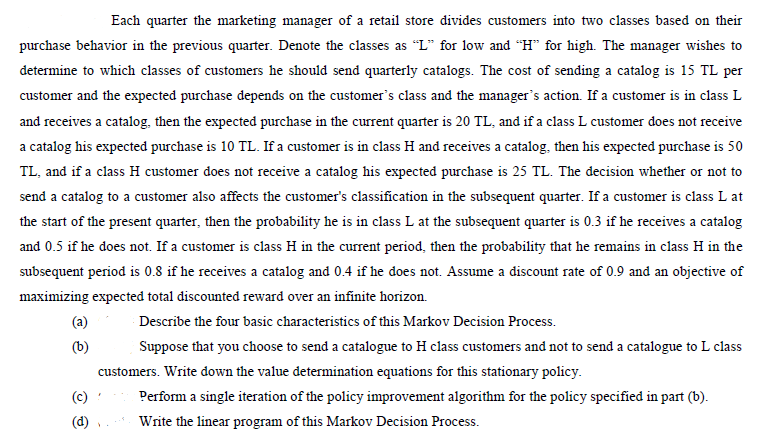
Each quarter the marketing manager of a retail store divides customers into two classes based on their purchase behavior in the previous quarter. Denote the classes as L for low and H for high. The manager wishes to determine to which classes of customers he should send quarterly catalogs. The cost of sending a catalog is 15 TL per customer and the expected purchase depends on the customer's class and the manager's action. If a customer is in class L and receives a catalog, then the expected purchase in the current quarter is 20 TL, and if a class L customer does not receive a catalog his expected purchase is 10 TL. If a customer is in class H and receives a catalog, then his expected purchase is 50 TL, and if a class H customer does not receive a catalog his expected purchase is 25 TL. The decision whether or not to send a catalog to a customer also affects the customer's classification in the subsequent quarter. If a customer is class L at the start of the present quarter, then the probability he is in class L at the subsequent quarter is 0.3 if he receives a catalog and 0.5 if he does not. If a customer is class H in the current period, then the probability that he remains in class H in the subsequent period is 0.8 if he receives a catalog and 0.4 if he does not. Assume a discount rate of 0.9 and an objective of maximizing expected total discounted reward over an infinite horizon. (a) Describe the four basic characteristics of this Markov Decision Process. (6) Suppose that you choose to send a catalogue to H class customers and not to send a catalogue to L class customers. Write down the value determination equations for this stationary policy. (c) Perform a single iteration of the policy improvement algorithm for the policy specified in part (6). (d) Write the linear program of this Markov Decision Process. Each quarter the marketing manager of a retail store divides customers into two classes based on their purchase behavior in the previous quarter. Denote the classes as L for low and H for high. The manager wishes to determine to which classes of customers he should send quarterly catalogs. The cost of sending a catalog is 15 TL per customer and the expected purchase depends on the customer's class and the manager's action. If a customer is in class L and receives a catalog, then the expected purchase in the current quarter is 20 TL, and if a class L customer does not receive a catalog his expected purchase is 10 TL. If a customer is in class H and receives a catalog, then his expected purchase is 50 TL, and if a class H customer does not receive a catalog his expected purchase is 25 TL. The decision whether or not to send a catalog to a customer also affects the customer's classification in the subsequent quarter. If a customer is class L at the start of the present quarter, then the probability he is in class L at the subsequent quarter is 0.3 if he receives a catalog and 0.5 if he does not. If a customer is class H in the current period, then the probability that he remains in class H in the subsequent period is 0.8 if he receives a catalog and 0.4 if he does not. Assume a discount rate of 0.9 and an objective of maximizing expected total discounted reward over an infinite horizon. (a) Describe the four basic characteristics of this Markov Decision Process. (6) Suppose that you choose to send a catalogue to H class customers and not to send a catalogue to L class customers. Write down the value determination equations for this stationary policy. (c) Perform a single iteration of the policy improvement algorithm for the policy specified in part (6). (d) Write the linear program of this Markov Decision Process







